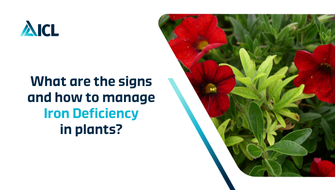An essential micronutrient, or trace element, Manganese (Mn) deficiency can lead to various symptoms and impact plant health and growth.

Manganese Deficiency in Kalmia
What are the symptoms of Manganese deficiency in plants?
- One of the most common and noticeable is interveinal chlorosis. The area between the leaf veins turns yellow, while the veins remain green, giving a net-like appearance.
- Severe cases can lead to the necrosis of chlorotic areas, resulting in tissue death reducing leaf size and overall plant vigour.
- Other symptoms, include reddish or purplish discolouration in older leaves, especially along leaf margins.
- Essential for chloroplasts, Mn deficiency can impair photosynthesis reducing energy production and significantly reducing plant growth – leading to stunted growth, reduced flower and fruit production, and poor root development.
How to spot a Manganese deficiency in spring?
Manganese deficiency occurs in new leaves, so can be found in new spring growth. With symptoms similar to iron deficiency, how do you tell the difference?
- Mn deficiency causes brown specks, and a lack of iron does not
- With Mn deficiency, leaf edges and veins remain green – while with iron deficiency they do not – the whole leaf turns yellow.
Now is a good time to inspect overwintered crops for signs of nutrient deficiency – to rectify any issues before the important spring sales season.

Manganese Deficiency in Spathiphyllum
How to manage Manganese deficiency in plants?
To guard against Manganese deficiency, use Micromax Premium
The ultimate trace element package, this superior granular fertiliser delivers all the vital trace elements, including Mn, in a single application. Its unique formula, maximising elements’ efficiency, helps optimise healthy plant growth and strong returns. Providing the perfect start-up effect, the trace elements are supplied to the plant for up to 16 months, with availability optimised even at a pH above 6.5. Ease and safe to use, Micromax Premium is routinely included in our Levington Advance bagged range and our Levington Advance bespoke mixes.
To rectify Manganese deficiency, use Peters Professional Foliar Feed
Delivering a super-fast response, this 100% premium grade water soluble fertiliser is an ideal leaf-feeding solution. The trace elements, including Manganese, remain readily available thanks to or unique M-77 improved chelating complex.
Did you know?
- Mn deficiency can disrupt the uptake of other nutrients like iron and calcium, further exacerbating nutrient imbalances in the plant.
- Mn availability is influenced by growing media or soil pH. At a high (alkaline) pH, it may become less available to plants. Adjusting the pH to the appropriate range can help improve manganese uptake.
- Excessive Mn levels can be detrimental to plants. Bark can contain high levels, so use quality pine bark. Mn toxicity can occur at low pH.
- Over-irrigating can leach manganese from growing media.
- Regular observation and early intervention are key to preventing and managing deficiency in horticultural crops.
- Weakened plants are more susceptible to diseases and pests, so manganese deficiency can make horticultural crops more vulnerable to various pathogens.

Manganese Deficiency in Pieris
0 Brands found
0 Products found
13 Resources found














